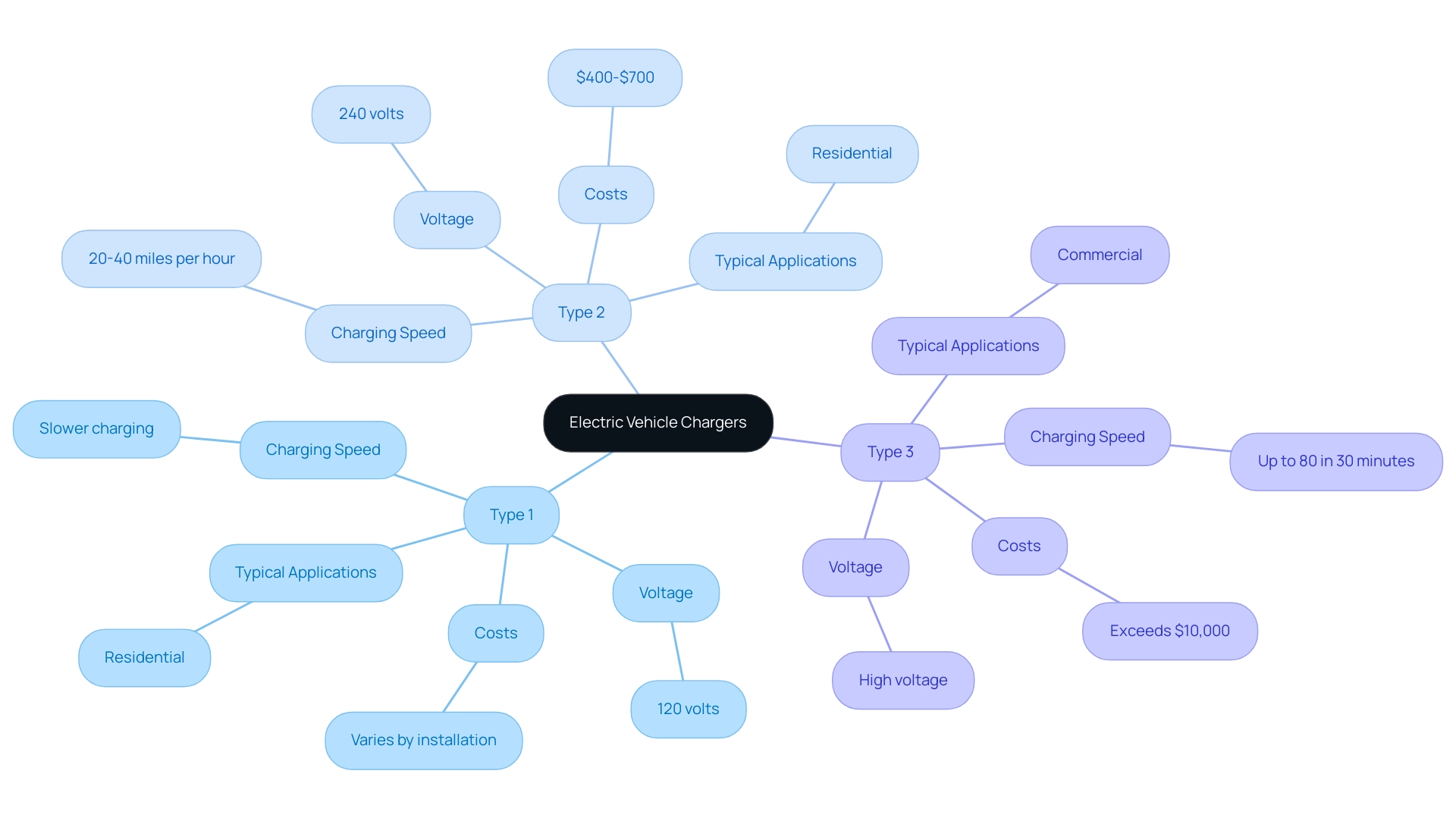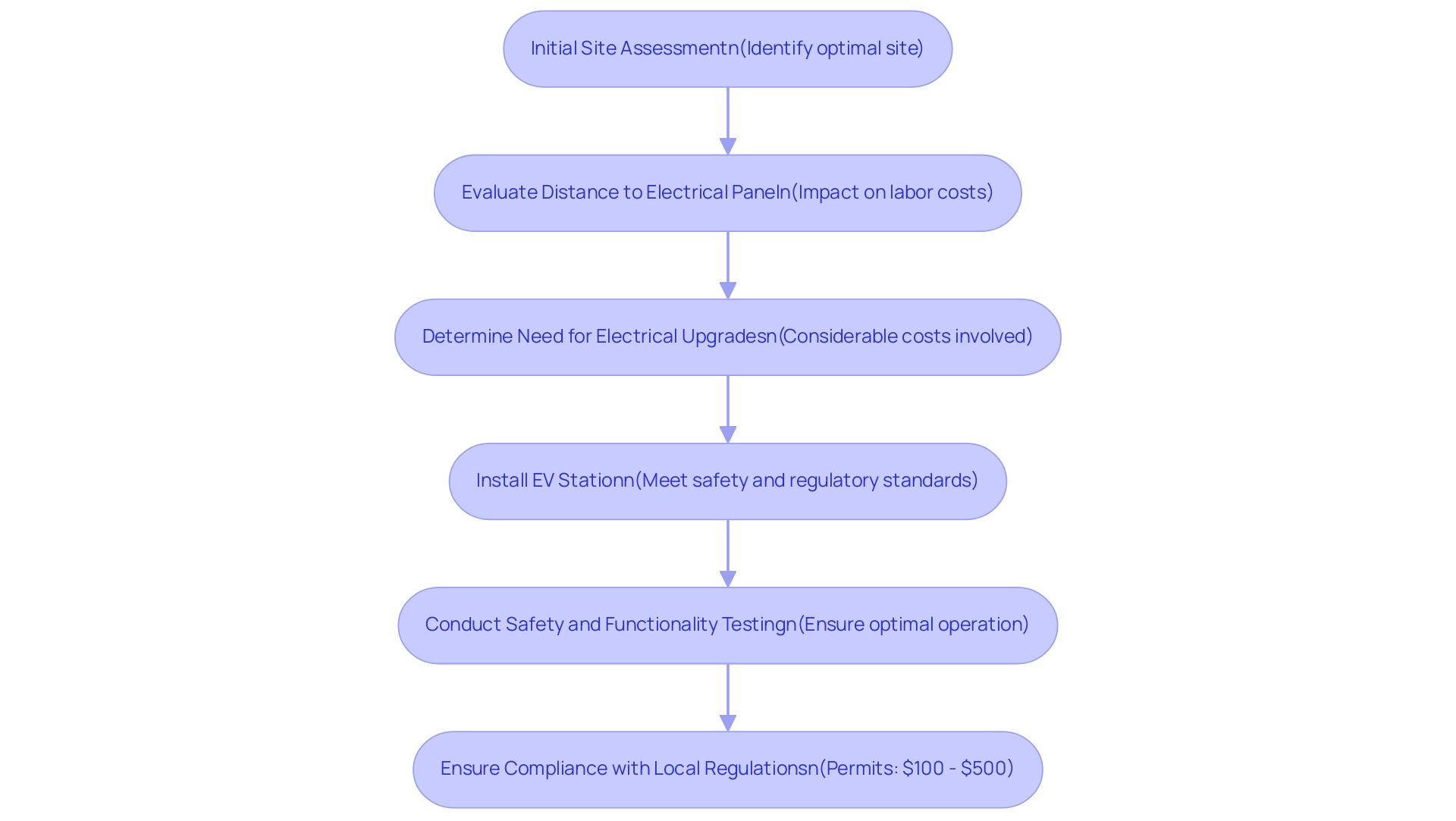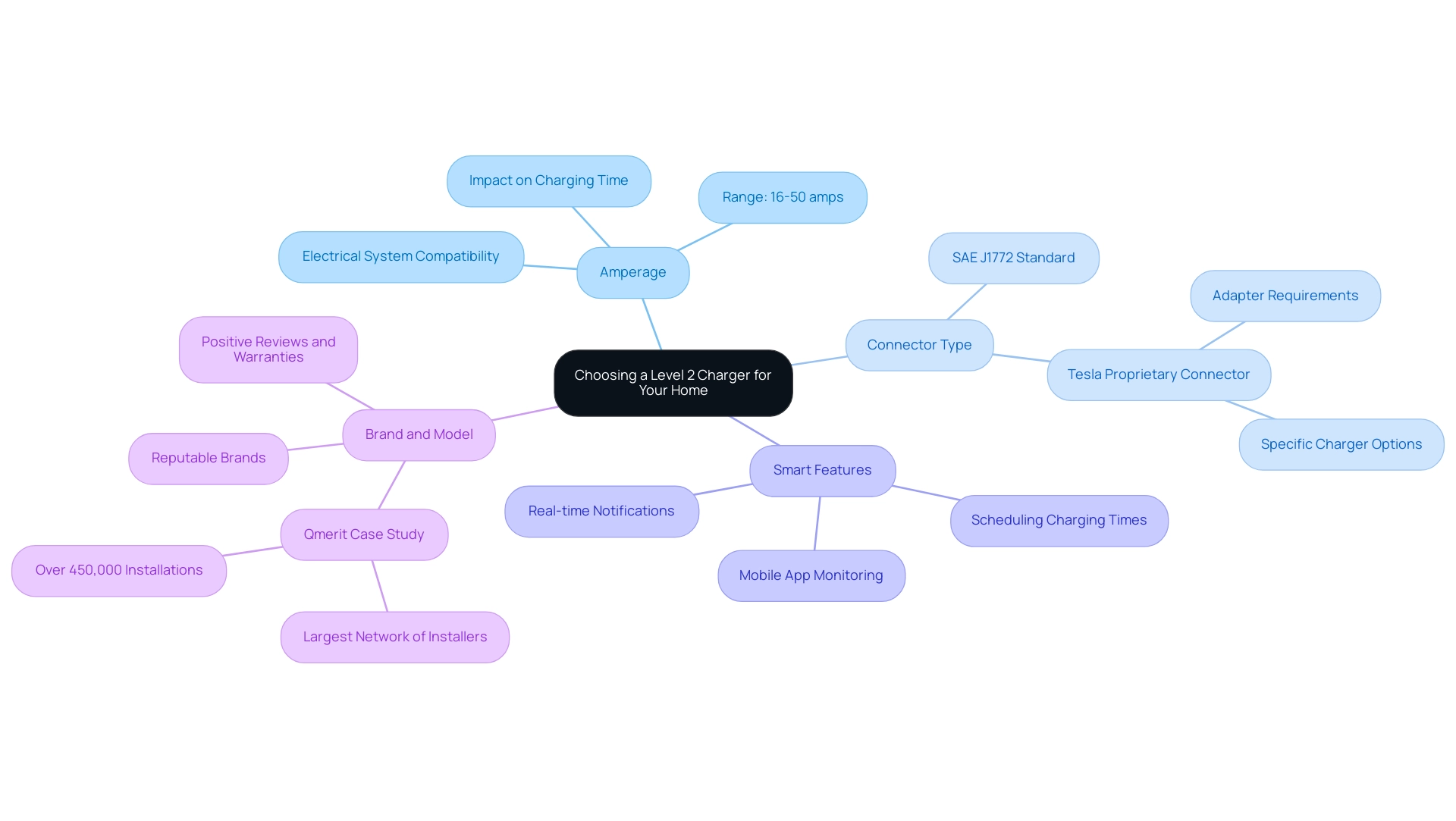Overview
We understand that the costs associated with transitioning to electric vehicle ownership can feel overwhelming. The price of a Level 2 charger typically ranges from $400 to $1,500 for the device alone. When you factor in installation expenses, the overall expenditure can rise to between $800 and $2,500. This range is influenced by various factors, such as the complexity of installation and the necessary electrical upgrades.
It’s common to feel concerned about both initial and ongoing costs. However, it’s important to consider the long-term benefits of energy independence and the potential savings on energy bills. Together, we can explore sustainable solutions that not only ease your financial concerns but also contribute to a greener future. Your journey towards electric vehicle ownership can be supported every step of the way.
Introduction
As the shift towards electric vehicles gains momentum, we understand that many homeowners are concerned about energy bills and the complexities of embracing this eco-friendly technology. Level 2 chargers, operating at 240 volts, offer a faster and more efficient charging solution compared to their Level 1 counterparts, making them a popular choice for home installations. With the ability to add significant range to electric vehicles in just an hour, these chargers not only enhance convenience but also align with the growing infrastructure supporting sustainable energy practices.
It’s common to feel overwhelmed by the journey ahead, but rest assured that the journey doesn’t end with installation; prospective owners must navigate costs, ongoing expenses, and available incentives to make informed decisions. Together, we can explore the nuances of Level 2 chargers, from installation factors and operational costs to selecting the right model, ensuring that eco-conscious homeowners can confidently transition to electric mobility.
Understanding Level 2 Chargers: An Overview
We understand that many homeowners are concerned about rising energy bills and the convenience of charging electric vehicles. Type 2 devices, functioning at an elevated voltage of 240 volts, significantly enhance your charging experience compared to the 120 volts of Type 1 devices. This increased voltage allows for quicker power replenishment, typically adding between 20 to 40 miles of range per hour, depending on your specific vehicle model. If you’re looking for even faster solutions, Tier 3 devices can supply up to 80% energy in roughly 30 minutes, making them an essential option for those aiming to enhance convenience in their daily lives.
Type 2 devices are particularly well-suited for residential setups, effectively meeting the needs of homeowners like you. In contrast, Type 3 devices are often found at public stations, providing rapid refills when you’re on the go. Unlike Type 1 units that utilize standard household outlets, Type 2 devices require a dedicated circuit and are commonly installed in accessible areas such as garages or driveways. For eco-conscious homeowners considering the transition to electric vehicles, understanding the operational functions of both Type 2 and Type 3 devices is crucial. They simplify the charging process, minimize downtime, and facilitate a smooth transition to electric mobility.
Moreover, with the top four DC fast networks—Tesla, Electrify America, eVgo, and ChargePoint—representing 88% of all DC fast units in the US, the infrastructure for electric vehicles is becoming increasingly robust. As David Hochschild, Chair of the California Energy Commission, emphasizes, ‘The expansion of effective charging alternatives such as type 2 and type 3 devices is crucial for speeding up the adoption of electric vehicles and fostering a sustainable energy future.’ When considering the cost of a level 2 charger, Type 2 units typically range from $400 to $700 for the device alone, with installation expenses varying based on home electrical systems. In contrast, Type 3 devices can exceed $10,000, including installation and infrastructure, making them more suitable for commercial applications.
By choosing Powercore Electric, you can trust our in-house team of specialists to ensure high-quality installations and maintenance of both type 2 and type 3 charging devices. We also offer extensive services, including solar panels, battery backups, and general electrical services. Together, we are committed to delivering effective EV charging solutions tailored to meet the needs of our Northern California community, supporting your journey towards energy independence and sustainability.
Breaking Down the Costs of Level 2 Chargers
When considering how much a Level 2 charger costs, it’s understandable to feel overwhelmed by the price range, which typically falls between $400 and $1,500. This range is influenced by factors such as brand reputation and specific features. Installation costs can vary significantly, averaging from $400 to $1,700 based on complexity and site specifics. Consequently, homeowners should anticipate a complete expenditure of around $800 to $2,500 when factoring in installation costs.
We understand that beyond these initial costs, there may be additional potential expenses, such as necessary electrical upgrades to ensure that your existing electrical panel can accommodate the new device. With most EVs traveling approximately 250 miles per charge, having a Type 2 charger at home significantly enhances convenience and accessibility for eco-conscious homeowners. As Voelcker pointed out, ‘Every electric car (Tesla included) can use public Level 2 stations,’ which emphasizes the advantage of investing in a home power solution.
Looking ahead, by 2030, worldwide lithium-ion automotive battery production capacity is anticipated to reach 3.2 TWh, indicating the rising demand for electric vehicles and the associated need for home power solutions. Conducting thorough research on various brands and models can assist you in identifying a power supply that aligns with your budget and specific needs. Moreover, while information regarding the effect of EV stations on property value is scarce, investing in a quality Level 2 system could enhance your home’s attractiveness to prospective buyers, making it a wise investment in a market increasingly focused on sustainable energy solutions.
For those evaluating their choices, Powercore Electric provides a variety of services, including installation of Tesla power stations, solar panels, and battery backups. This ensures that homeowners like you can make informed decisions about your energy solutions. Together, we can explore our recent posts on Tesla home charging devices, solar panel functionality, and available government programs that support eco-friendly upgrades, such as the benefits of solar battery backups and the latest trends in EV charging technology.
Key Factors Affecting Installation Costs
Several key factors can significantly impact the cost of installing a Level 2 charger, and understanding these elements is crucial for eco-conscious homeowners looking to manage their budgets effectively. We understand that the distance from your electrical panel to the installation site plays a vital role in determining labor costs. Longer distances often necessitate additional wiring and labor, which can increase overall expenses. For instance, outdoor installations can incur higher costs due to weatherproofing and longer cable runs, as highlighted in a case study comparing indoor versus outdoor EV refueling station installations.
At Powercore Electric, we perform a comprehensive evaluation of your property to identify the optimal site for the station and examine any electrical needs. This initial assessment is essential for ensuring the most efficient installation process, allowing you to feel confident in your investment.
An outdated electrical system may not support the added load imposed by a Level 2 charger. Upgrading your electrical panel can be a necessary step, but it also adds considerable costs. As one experienced electrician noted,
The necessity for electrical upgrades can often be the most significant factor in the overall installation cost.
Depending on the existing electrical infrastructure, modifications may be required to accommodate the power station. Once the site assessment and electrical upgrades are complete, we install the EV station, ensuring it meets all safety and regulatory standards. This phase is crucial for ensuring the functionality and safety of the installation, providing peace of mind.
After installation, we rigorously test the station to ensure it’s functioning optimally before handing it over to you. This step is critical to confirm that everything operates as intended and should be recognized as a distinct phase in the installation process. It’s common to feel concerned about the final stages of installation, but rest assured, we prioritize your satisfaction.
Local regulations may require permits for installation, which can range from $100 to $500. It’s essential to check with local authorities to ensure compliance with all legal requirements. Hiring a licensed electrician is crucial for both safety and compliance with regulations. Labor costs can differ depending on the area and the intricacy of the setup, with authorized specialists generally requesting higher fees because of their skills.
By taking these elements into account, property owners can more effectively plan for the financial impacts of installing a Type 2 device. Together, we can ensure a smoother transition to electric vehicle ownership while understanding the costs involved in installing a Level 2 charger.
Ongoing Costs of Operating a Level 2 Charger
Owning a Level 2 charger brings with it several ongoing costs that eco-conscious homeowners should thoughtfully consider, especially when looking to integrate it with solar panel systems and battery backups offered by Powercore Electric.
Electricity Costs: We understand that managing electricity costs is a primary concern for many homeowners. In California, powering an electric vehicle at home typically ranges from $0.10 to $0.30 per kilowatt-hour (kWh). For instance, charging a vehicle with a 65 kWh battery can cost around $11 for a full charge, influenced by local electricity rates. However, with the addition of solar panels from Powercore Electric, residents can significantly reduce these expenses by generating their own electricity. Powercore Electric provides high-efficiency solar panels that maximize energy production, further lowering electricity bills. Additionally, charging a Ford Mustang Mach-E incurs an extra $13.60 for every 1,000 miles traveled compared to a Tesla Model 3, highlighting the financial implications of different electric vehicle options. Given the rising popularity of electric vehicles, this cost is a crucial factor for homeowners to consider.
Maintenance Costs: It’s common to feel apprehensive about maintenance expenses. Although Level 2 chargers are designed for low maintenance, periodic inspections and possible repairs are essential for optimal functionality. Homeowners should budget around $100 to $300 annually for these maintenance needs, ensuring their charging system remains reliable. By integrating Powercore Electric’s battery backups, homeowners can enhance overall system efficiency, allowing them to store excess solar energy for use during peak hours or outages.
Network Fees: For those utilizing smart devices connected to a network for enhanced management and monitoring, additional subscription fees may apply. This can vary based on the service provider, so it’s wise to investigate these costs when selecting a charger.
As Greg Sowder, President of Qmerit Network, states, “Rated #1 in customer satisfaction, Qmerit’s experienced network of certified electricians has installed more than 450,000 EV charging stations in homes and businesses across the U.S. and Canada!” This emphasizes the importance of choosing a trustworthy installation service, like those offered by Powercore Electric, which also provides competitive pricing on solar panel installations and battery choices for residents.
By carefully assessing these ongoing costs and exploring how much a Level 2 charger costs, property owners can gain a clearer understanding of the overall ownership expenses related to their Type 2 device. Furthermore, a case study comparing the cost of driving 100 miles in a Tesla Model Y, which costs $4.45 for 100 miles, versus a gasoline vehicle at $10.96 and a hybrid at $7.87, demonstrates the cost-effectiveness of electric vehicles. Together, we can support your journey towards sustainable energy practices with Powercore Electric’s comprehensive offerings, including transparent pricing and tailored solutions to fit your individual needs.
Exploring Savings and Incentives for Level 2 Charger Installation
As eco-conscious homeowners, you may often find yourself concerned about rising energy bills. Installing a Type 2 electric vehicle (EV) station can be a significant step towards alleviating those worries while embracing sustainable solutions. The average installation cost for a Tesla Level 2 charging station typically ranges from $1,200 to $2,000, influenced by factors like location and necessary electrical upgrades. Did you know about the Federal Tax Credit? Homeowners can claim a federal tax credit worth 30% of the installation costs, capped at $1,000. This incentive directly reduces your overall expenses during the installation process, making it a valuable investment in EV technology.
Moreover, if your project meets prevailing wage and apprenticeship requirements, you may qualify for a tax credit equal to 30% of the cost of property subject to depreciation. State and Local Incentives are also available; for instance, California offers various rebates and incentives designed to promote EV charger installations. These programs can significantly cover a portion of your installation costs, enhancing the appeal of transitioning to electric vehicles and making it easier for you to adopt sustainable energy solutions.
Additionally, many utility providers have launched rebate initiatives or special pricing schemes that reward residents for charging their EVs during off-peak hours. By participating in these programs, you can achieve substantial savings on your electricity bills, further offsetting the costs linked to EV ownership.
While these incentives make the switch to electric vehicles more financially feasible, it’s common to feel uncertain about the installation process or the long-term savings associated with EV ownership. As Kelley R. Taylor, Senior Tax Editor, points out, understanding the complexities of federal and state tax information can empower you to make informed decisions regarding your investments in EV technology.
By taking advantage of these diverse incentives, you not only make the transition to electric vehicles more financially accessible but also align with sustainable practices that encourage a greener, eco-conscious lifestyle. Together, let’s work towards a more sustainable future, knowing that support and guidance are available every step of the way.
Choosing the Right Level 2 Charger for Your Home
When selecting a Level 2 electric vehicle (EV) charger for your home, it’s important to consider several key factors that can significantly impact your experience and satisfaction. We understand that many homeowners are concerned about energy bills and the efficiency of their charging solutions, so let’s explore how to make the best choice for your needs.
- Amperage: Level 2 chargers typically range from 16 to 50 amps. Opting for a higher amperage can greatly reduce charging time, but it’s essential to ensure that your home’s electrical system can safely accommodate this increased load. According to the McKinsey Mobility Consumer Pulse Survey, many homeowners express a preference for faster charging capabilities, highlighting the importance of careful amperage selection.
- Connector Type: The SAE J1772 connector is the standard for most electric vehicles. However, if you own a Tesla, you’ll need to consider its proprietary connector, which may require an adapter or a specific charger designed for Tesla compatibility. It’s crucial to ensure that your chosen charger meets your vehicle’s requirements to avoid any inconvenience.
- Smart Features: Many modern chargers come equipped with smart technology, allowing you to monitor your charging sessions through mobile applications. Features like scheduling charging times and receiving real-time notifications can greatly enhance your experience and contribute to energy efficiency, making your life a little easier.
- Brand and Model: Researching reputable brands is vital. Look for chargers with positive reviews and solid warranties. Trusted brands often have a track record of customer satisfaction and reliability, providing peace of mind for your investment. For example, Qmerit, recognized as the largest network of certified EV installation professionals in North America, stresses the importance of choosing trusted brands for installation, with over 450,000 setups demonstrating their reliability.
By thoughtfully considering these factors, you can select a Level 2 charger that not only aligns with your lifestyle but also enhances your charging speed and supports sustainable energy usage. As consultant Ali Tanweer wisely notes, “The only question that remains is how quickly industry stakeholders will act to meet consumer expectations.” This underscores the urgency for homeowners to make informed decisions in the evolving EV market. Together, we can navigate these choices and work towards a more energy-independent future.
Conclusion
Investing in a Level 2 electric vehicle charger is not just a decision; it’s a meaningful step toward embracing sustainable energy solutions that enhance convenience for eco-conscious homeowners. We understand that navigating the complexities of energy bills can be overwhelming, but by grasping the operational advantages, installation costs, and ongoing expenses associated with these chargers, you can make informed decisions that align with your lifestyle and budget. The ability to charge your electric vehicle more efficiently not only saves precious time but also supports our collective goal of reducing carbon footprints.
Moreover, the availability of various savings and incentives, such as federal tax credits and state rebates, makes the transition to electric vehicle ownership more accessible and financially feasible. Together, these incentives, combined with the potential for lower electricity costs through solar integration, create a compelling case for investing in a Level 2 charger.
Ultimately, choosing the right charger involves careful consideration of factors such as amperage, connector type, and smart features. By prioritizing these elements, you can ensure that you select a charging solution that not only meets your needs but also contributes to a greener future. It’s common to feel uncertain about where to start, but as the infrastructure for electric vehicles continues to grow, now is the time to take action. Let’s embrace the benefits of electric mobility together, and take this important step toward a sustainable future.






